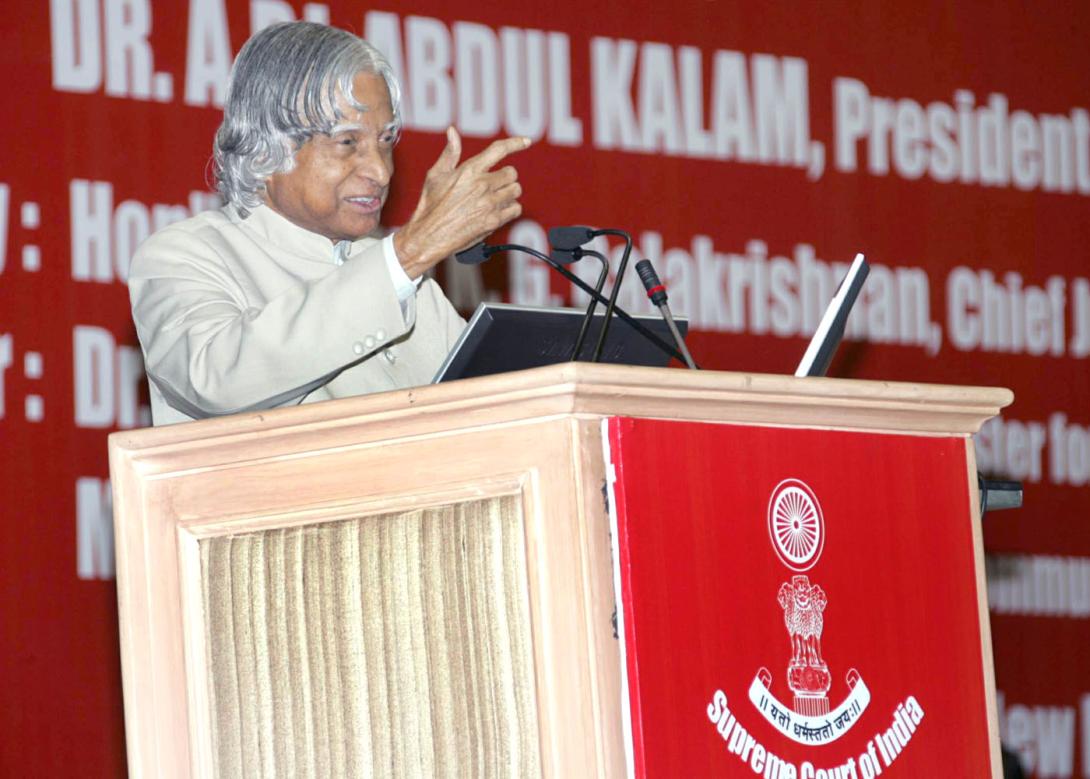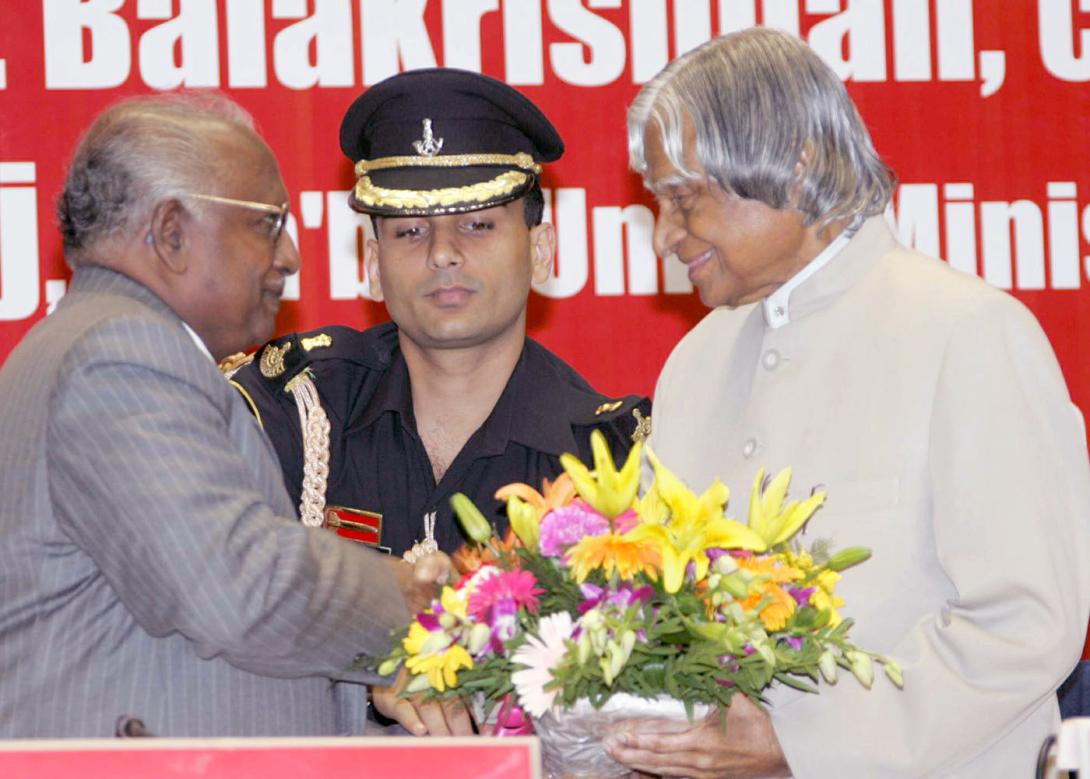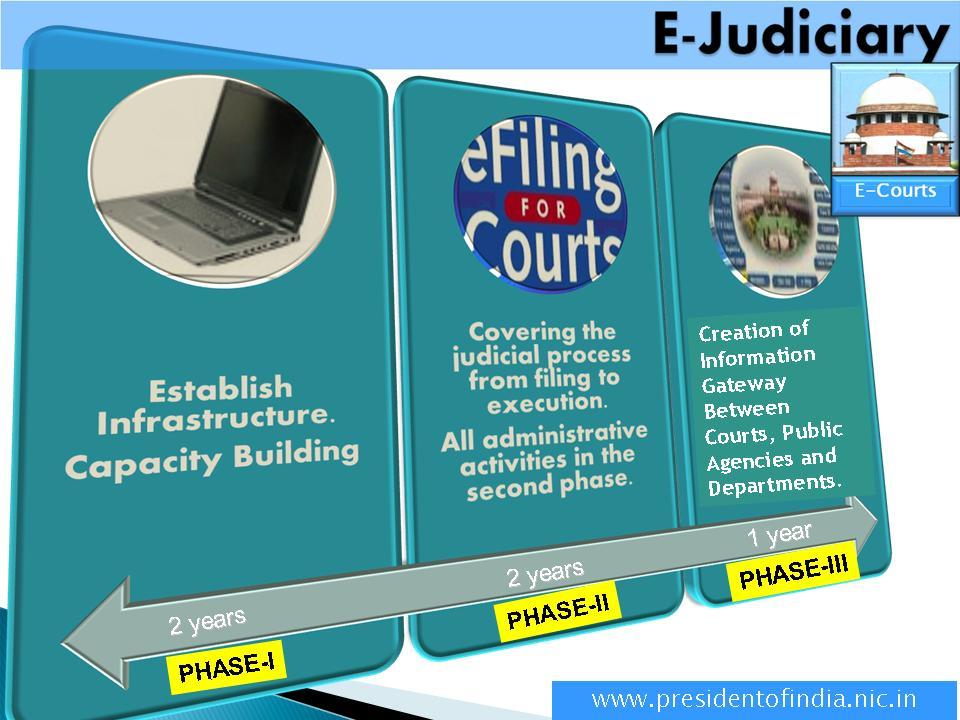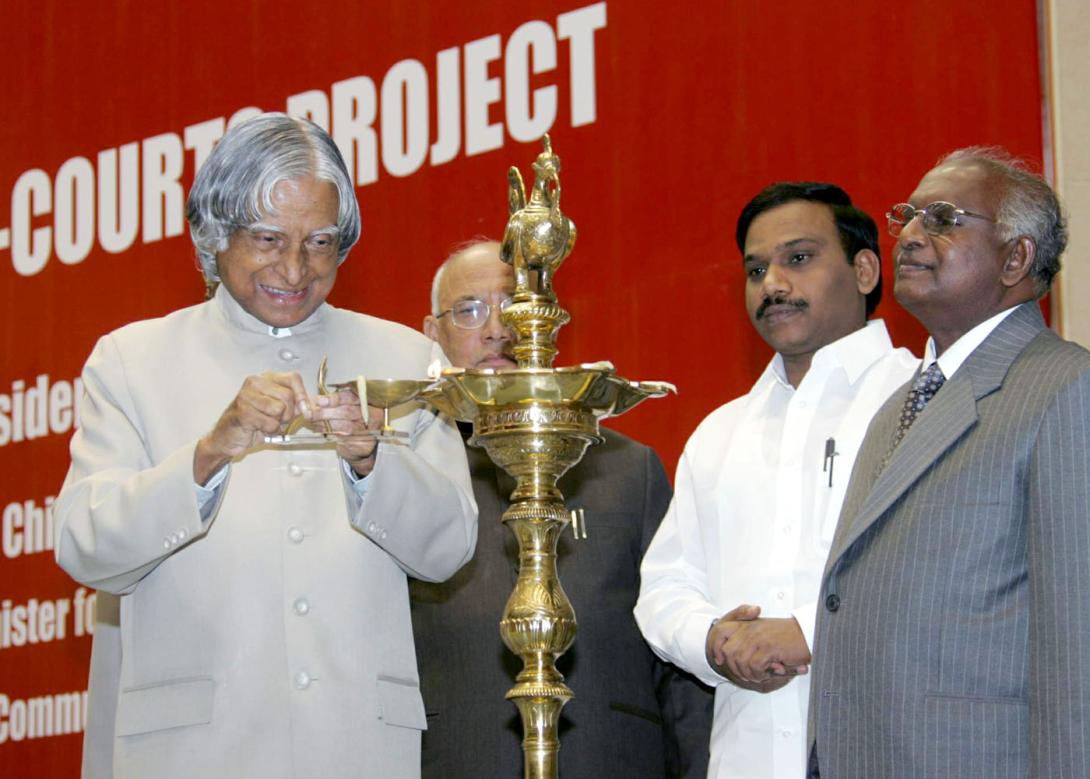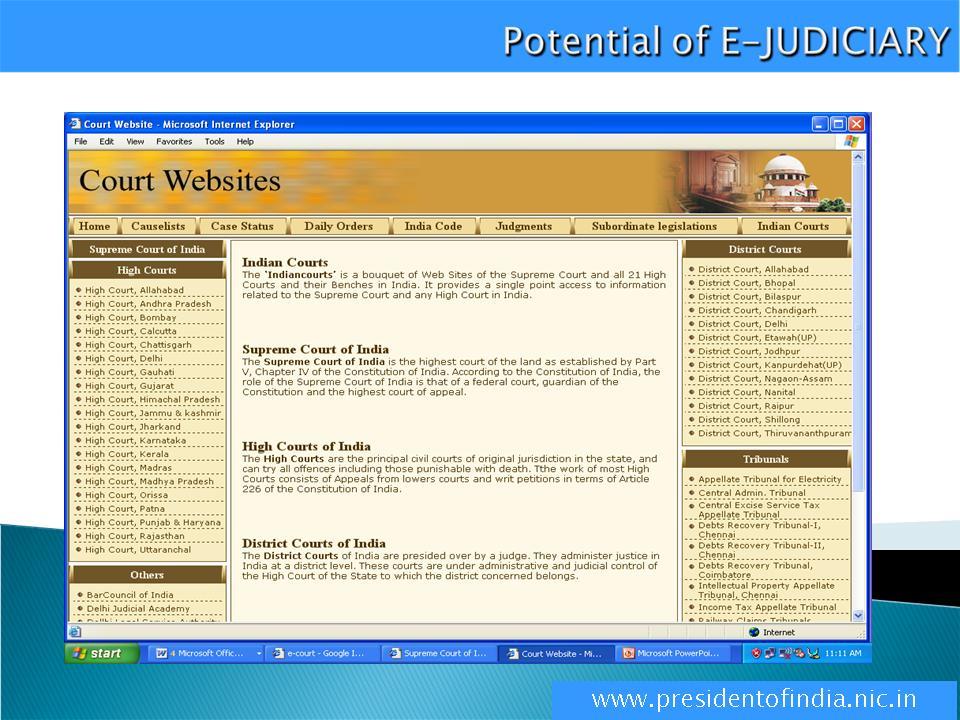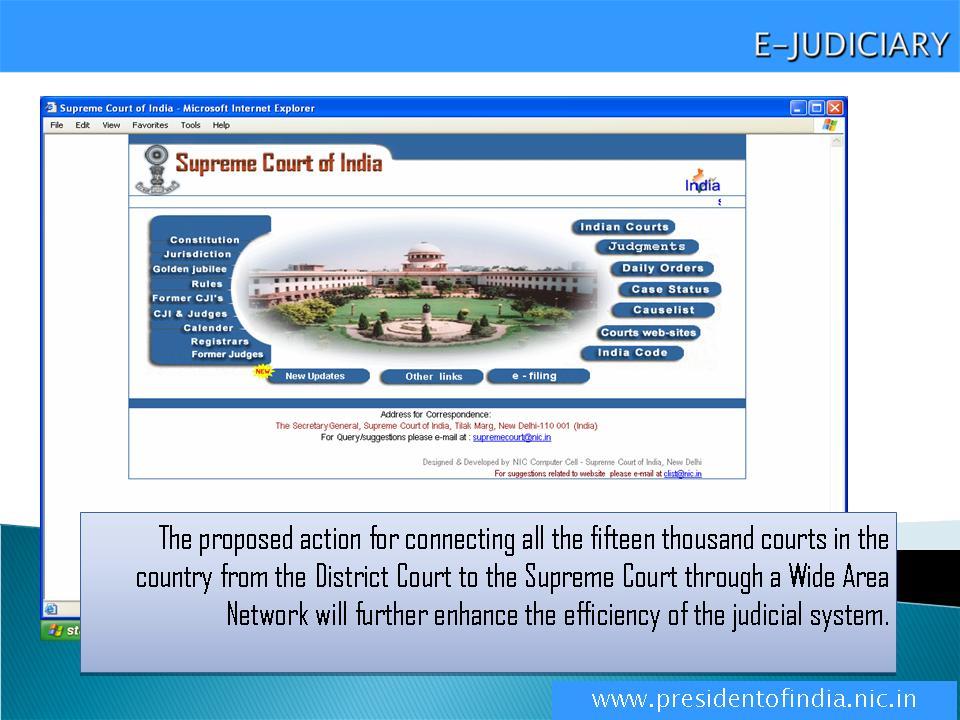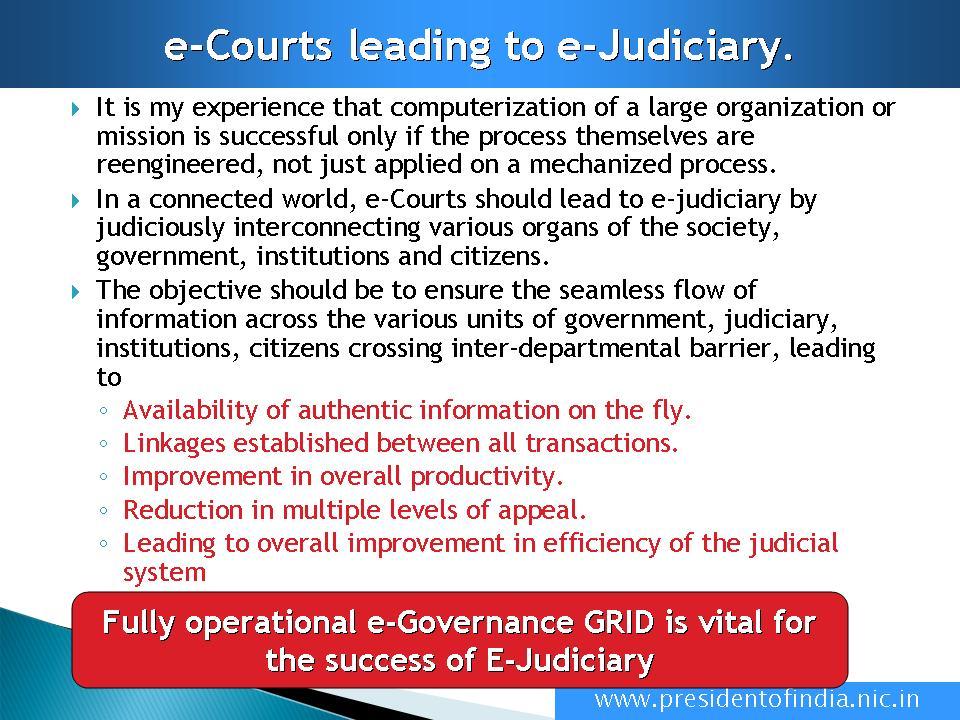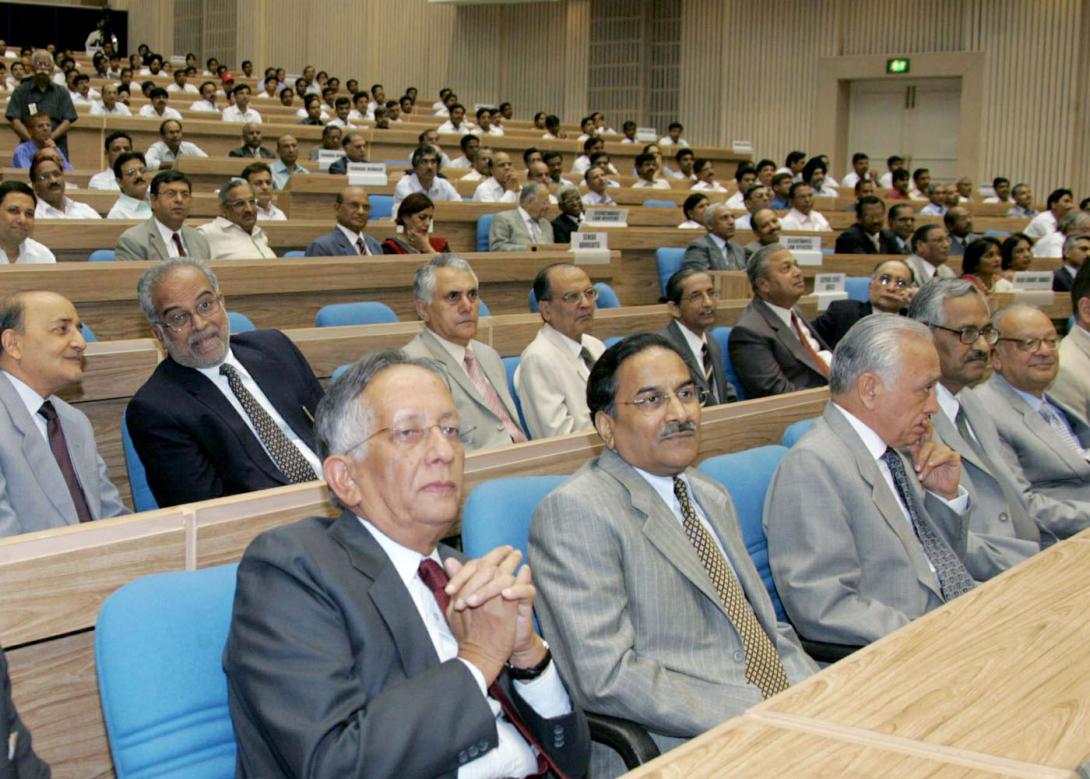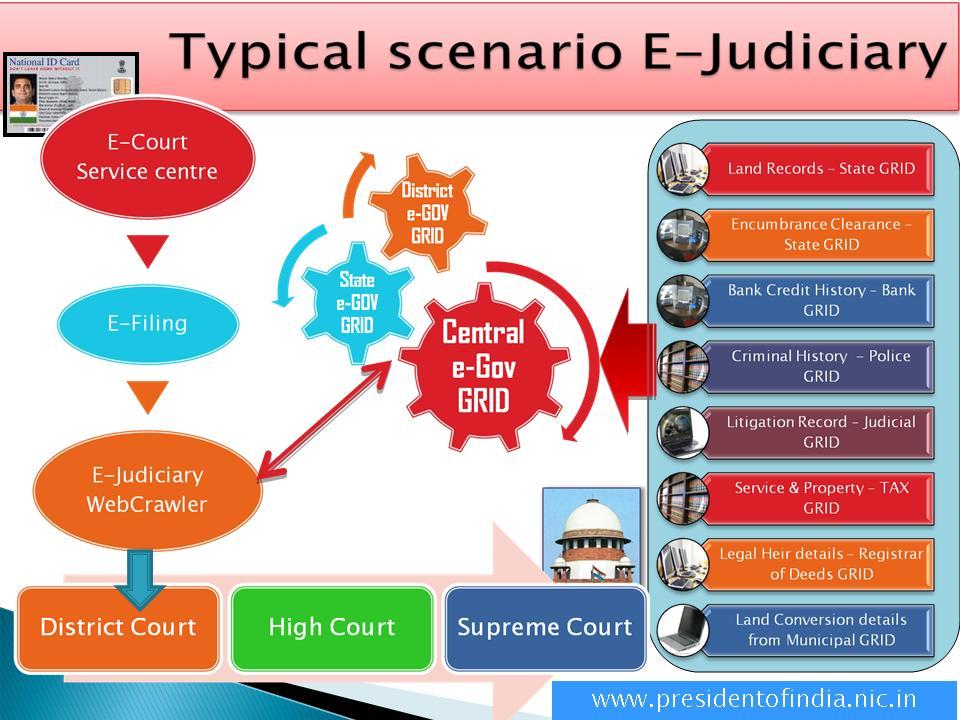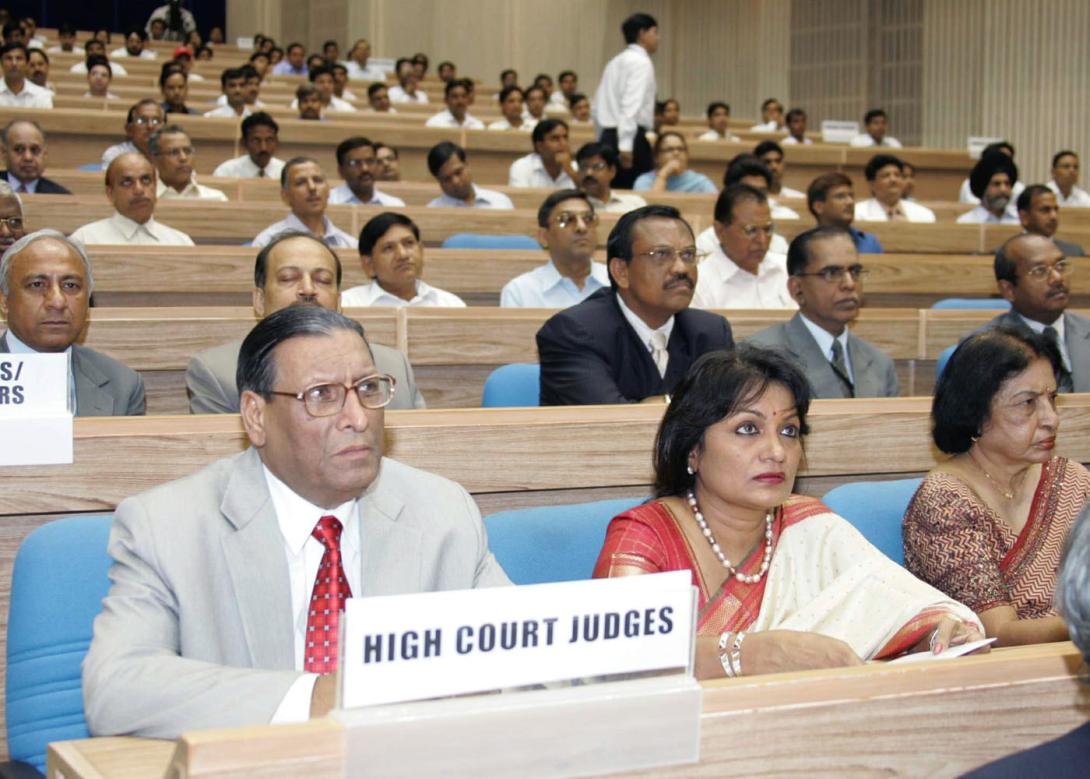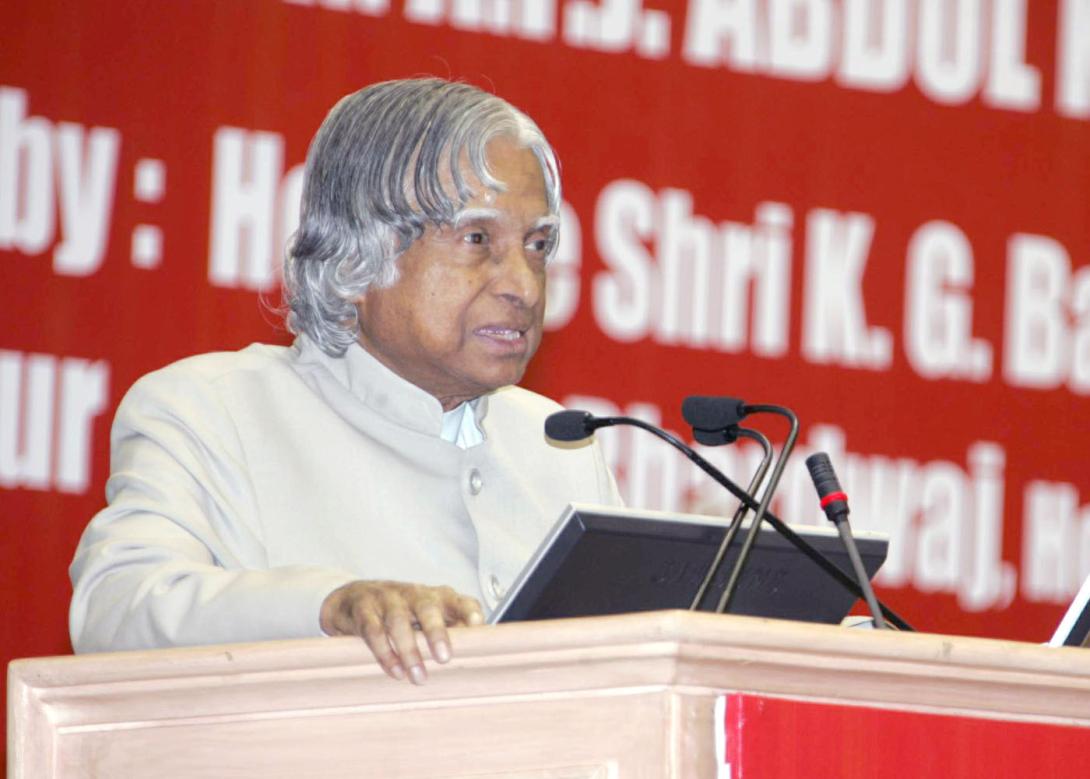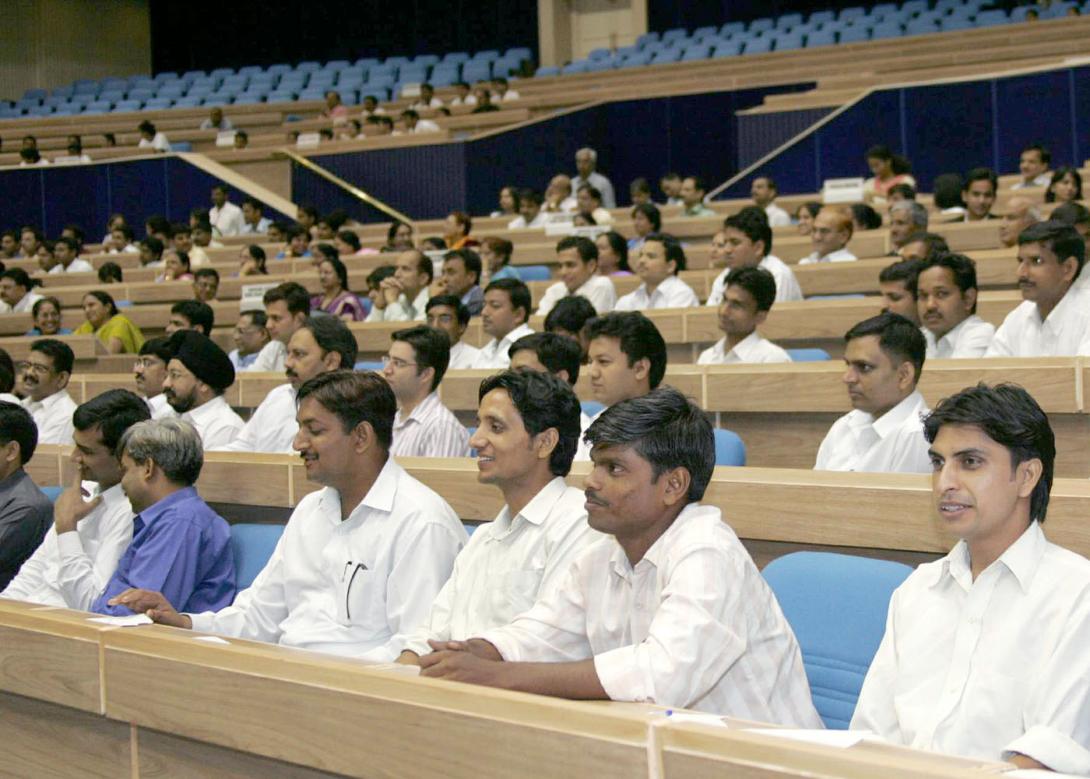Address During the Launch of Computerization of Courts, New Delhi
New Delhi : 09-07-2007
Evolution of e-Judiciary
"e-Judiciary needs an environment of National e-Governance GRID"
I am delighted to participate in the launching of computerization of courts organized by Supreme Court of India. My greetings to Honorable Chief Justice of India, Honorable Justices of Supreme Court, Members of the Bar, administrative officers, staff and the members of E-Committee. In the last 5 years, I would have interacted with many High Courts and the Supreme Court for more than 15 times on various occasions. I am very happy that substantial progress has been made in the courts to improve the justice delivery system such as specific efforts for bringing down the pendency of cases, fast settlement of cases especially pertaining to women and children and the use of technology for handling certain special cases. I also see the websites of various courts and I am convinced that the courts are constantly improving the systems and procedures using ICT tools and are making timely information available to people thus ensuring courts are friendly to citizens. I appreciate the ?e-courts? efforts taken by the Supreme Court of India in three phases as a mission mode project under the National e-Governance Plan (NeGEP). It is planned to provide necessary infrastructure and concentrate on capacity building, judicial process from filing to execution and finally making the information available online between the courts, prosecuting and investigating agencies, prisons, land records and registration offices thereby accelerating disposal of civil and criminal cases. While you are concentrating on the computerization of courts for transforming them into e-Courts in three phases, I would like to focus on creating the e-judiciary by establishing the Judicial e-Governance grid from the district courts to the Apex Court, thereby creating a vertical e-Governance grid for covering the whole judicial system of the country. This Grid will ensure seamless flow of information and case objects across the inter-departmental barrier in a G2G mode across the vertical grid. This will be supported by the other horizontal e-Governance grid from the State and Central Government related to the particular case object which will facilitate the case objects to flow across the judicial process at various stages ensuring the speed, transparency and inter-operability thereby eliminating duplicity and ensuring the speedy justice. For an effective e-Judiciary, national identity card has to be the primary database linking all the e-Governance activities.
Potential of e-Judiciary
Computerization of the High Courts and the District Courts is essential for the development of e-judiciary system. From the time the case is filed till it is disposed off with judgment, the entire processing must take place electronically. This will enable easy search, retrieval, grouping, information processing, judicial record processing and disposal of the cases in a transparent manner and enable quicker disposal of cases. At any time the complainant should be able to find out, what the stage is? Which Court? Which date? and which subject will be dealt with by the Court during a particular hearing, enabling the parties to be fully prepared for the case. Apart from bringing in total transparency in the case, the judges can also see how the case has progressed, how many adjournments have been sought, whether the grounds are trivial or serious and many such information which will make the delivery of justice impartial. Supreme Court should transform the present mission into ?e-judiciary? mission. In certain High Courts, e-Court system has started functioning. The proposed action for connecting all the fifteen thousand courts in the country from the District Court to the Supreme Court through a Wide Area Network will further enhance the efficiency of the judicial system. The e-Judiciary initiative within the overall justice delivery system should help in transforming the Court service into a better focused system in meeting the needs of the citizens. e-Judiciary will have to be in a position to provide information in real time on the rights and responsibilities of the citizens.
e-Courts leading to e-Judiciary ? A Vision
It is my experience that computerization of a large organization or mission is successful only if the process themselves are re-engineered for realizing the full benefits of automation. In a connected world, e-Courts should lead to e-judiciary by judiciously interconnecting various organs of the society, government, institutions and citizens. The objective of e-Judiciary should be to ensure the seamless flow of information across the various units of government, judiciary, institutions, and citizens crossing the inter-departmental barriers leading to: - Availability of authentic information on the fly. - Linkages established between all transactions. - Improvement in overall productivity. - Reduction in multiple levels of appeal. e-Judiciary thus ensures the overall improvement in efficiency of the judicial system. With the progressive improvement that I am seeing in the Judicial System in our country, you will certainly achieve the vision of transforming the present system into e-Judiciary system. In this context, let me now explain, my visualization of a typical scenario in the environment of e-judiciary.
Typical scenario
E-Judiciary ? a Vision: My visualization of a typical scenario is where a citizen files a case for a civil dispute of a piece of land in the e-Court using his or her National ID CARD and he gets a justice within two weeks of time. Let me unfold the scenario. A litigant comes with his national ID to the e-Court Service Centre in a District Court with all the documentary evidence which he possesses. e-Court Service Centre helps electronically to identify a civil lawyer to present his case. The lawyer files the case with a prescribed format in the e-Court. Once the case is filed, the e-Court web service agent crawls across the state and central e-governance grid and collects the relevant land records registry and gets the encumbrance certificate details of the litigants and the defendants. If necessary, it also collects the credit history of the parties from the banking grid, criminal record if any from the police grid, litigation records if any from the other courts, property tax and service tax payment data for the particular disputed land from the State e-governance grid, legal heir verification from the Registrar of Deeds and classification and conversion details of the particular land from the district e-governance grid. The judicial officer now has the documentary evidence submitted by the litigant and defendant and the certified and authentic documentary evidence collected from various government units which have relevance to this case on the fly in front of him. This will enable the judicial officer to apply his or her mind objectively with optimal examination and cross-examination of the witnesses leading to taking a fast decision in the particular case. Linkage with NeGEP (National e-Governance Programme): This entire process happening in the network speed reduces the time gap in judgement. Affected party can go online for appeal with the judgement giving reasons and further documentary evidence to the higher court electronically if required. Higher courts get the entire data electronically and they can apply their legal provisions to entertain the case based on its merit and give their verdict without loss of time. The entire e-governance framework should facilitate the case to flow digitally in a secure environment with digital signature across the various stages within the court and across the courts. The data collection and verification with different respondents cutting across various institutions and individuals takes place in a seamless interoperable manner through the e-governance grid data collection mechanism. This data is presented in the form of text, audio, video right from the FIR, interrogation, enquiry, arguments and judgements. The case object is flowing digitally from District Courts to High Courts and High Courts to Supreme Court in a seamless fashion. The other horizontal and vertical e-governance grids such as police grid, banking gird, institutional grids, state grid and central government grid will assist the e-judiciary electronically and facilitate the decision making process in a transparent manner. Basically, in an e-judiciary environment, a case object is traveling into various stages of judicial process and creates Meta data in each stage of the judicial process, thereby creating a foot print of data about the case. An ICT legal expert system assists the advocates and the judges with the legal provisions, previous case history, previous judgement details in various courts thereby helping them to arrive at a decision based on the spirit of the legal provisions. Hence a fully operational e-Governance GRID is vital for the success of E-Judiciary. Information flow for innovation: E-judiciary system should also help the judicial officers to categorize various cases and group them into number of categories so that innovative mechanisms can be found to reduce the pendency of cases in categories which have common law point. For example, in more than 50% of the pending cases Central or State Government is the respondent. These cases have arisen due to certain anomalies in the rules, regulations, interpretation and its implementation. E-judiciary system should be able to classify all the cases which are filed against the government into specific categories which can be collectively examined by the judiciary. This type of examination will enable the judiciary to provide advice to the Government for incorporating suitable modifications of policies and procedures in meeting the ends of natural justice for every citizen of the nation.
Prevention of cyber crimes
Though ICT has been a tool for speeding up the justice system, we would soon witness in our digital economy, more and more crimes committed using ICT itself. These are now known world over as cyber crimes. In the present law, for example, the jurisdiction will correspond to the location where the crime is committed and where the damage occurs - very often both being the same location. Whereas in the digital world, the crime may originate from a strange place even outside our own shores and may damage organizational wealth which will be in the digital form in multiple locations. In the world of cyber crimes, the distinction between fun and crime, accidental and premeditated offences and even indirect and insinuated crimes become blurred. In such situations, the judges, the lawyers, the police and the law officers should be trained to be aware of such possibilities of technology centric crime much the same way they have been trained to understand crime in the physical world. To ensure timely implementation of the e-judiciary system, certain actions related to the process and education are essential. 1. Encouraging increased awareness of legal rights and responsibilities as a part of life long learning in a knowledge based society. To realize this the members of legal literacy group should train self-help group members who are undergoing courses on tailoring, beautician and other vocational courses on family laws, marital laws, maintenance and inheritance under various religious legal systems. The provisions of consumer protection act, food and adulteration act and other relevant laws should also be explained to them. This will enable them to protect their lives and also become ethical entrepreneurs. 2. Ensuring that the whole judicial process is transparent and is a true reflection of our societal values. 3. Helping ensure selection of most appropriate form of dispute resolution. 4. Ensuring that there are training programmes at all levels including among law students, teachers, various levels of courts, so that there is no gap in realization of the system and its implementation. It will be necessary that certain Courts are chosen as model Courts in the country to implement all the elements of e-judiciary so that the pros and cons of the system can be studied by all the constituents of e-governance system. This study should enable freezing of the overall specification of e-judiciary before implementing in all the 15,000 courts in the country.
Suggestions
The three phase approach for e-Courts formulated by Supreme Court is an important step towards the development of a comprehensive e-judiciary system. I would like to make the following suggestions so that the planning e-judiciary system can be well interfaced with the national e-governance system to ensure the robust and fast judiciary process with transparency. 1. e-Judiciary may work with the Ministry of Communication and Information Technology to drive seamless information flow with national ID as a primary data base and full utilization of National e-Governance Grid across the State and Central Government cutting across inter-departmental barriers.
2. Consider creation of a Judicial e-Governance Grid supplemented with the creation of Police e-Governance Grid, State and Central e-Governance Grid particularly for Land records, Service and Property Tax, Knowledge GRID, Healthcare GRID, Civil Registration System, e-Governance GRID, Essential Institutional Grid for providing support to Judicial system may be taken up in a First phase with PKI infrastructure in a secured VPN Environment with dynamic workflow mechanism.
3. Consider formulating standards, protocols, infrastructure, platforms and language independence by Unicode adoption for interoperable e-Governance system across the National E-Governance GRID in the nation. These standards will enable realization of optimal gain from the overall e-Governance project under the NeGEP.
4. Instead of choosing the conventional video conferencing system, with the growth in ICT technology and the MPLS network and increasing bandwidth, we have the opportunity to transform in to an IP based multimedia tele-conference system in a cost effective manner across the network.
5. Consider establishing the e-judiciary service centers in all the court complexes for generating the digital inputs to the e-Judiciary system, so that from then onwards, the case object will flow through the various stages of judicial process and thereby creating a meta data of events and thus delivering the speedy justice.
6. Consider taking integrated action in all the areas of e-Governance systems stated in 1 to 5 above for synergizing the efforts which will lead to economy, speed and responsiveness of the overall governance including the judicial system.
7. Aim of the e-Courts system should be to bring down the pendency by more than 60% in district courts from the existing 2.5 crore, in the high courts from the existing 36 lakh and in the Supreme Court from the existing 41,000 cases to 10,000 cases by the year 2012.
Conclusion
Our judicial system is dynamic and an institution which is throbbing with life catching up societal and technological evolution. As the ultimate protector of human rights and the final resort for dispensation of justice, the citizens of India look up to this institution with hope. Our Society is going through a unique dynamics due to the shortage of leadership with nobility. The only hope the nation cherishes and looks to is the judiciary with its excellence and impeccable integrity. We should do everything to make the judicial system succeed. It is said that a nation fails not because of economic progress but because of an increase in decision makers with small minds. This casts a very heavy responsibility on the entire judicial system to live up to the expectations reposed in it and to maintain the sacred aura attached to it unsullied. Qualities of honesty and integrity are synonymous with each member of the judicial system. e-judiciary will be an enabler in the realization of transparency, speed and equity in the judicial decision making process. With these words, I launch the Computerization of Courts by the Supreme Court of India. I am confident that with the effort taken, Indian model of e-judiciary can become the best in the world. My best wishes to all the leaders and the members of this initiative success in their mission of providing speedy and transparent justice system to all our citizens. May God bless you.
OATH FOR LAW STUDENTS
1. I will uphold the spirit of justice in all my actions and ensure that the affected persons get justice.
2. I will create an awareness among the citizens about the rights, law and the constitution and also about their responsibilities.
3. I will work for reducing the pendency of court cases at levels of judicial process.
4. I will adopt the e-governance to improve the transparency and smartness of justice delivery system.
5. I fully believe in e-Judiciary, I whole-heartedly extend my support to achieve 100% e-judiciary in the country.
6. I will always uphold righteousness in the heart in all my actions.
Righteousness Where there is righteousness in the heart There is beauty in the character. When there is beauty in the character, there is harmony in the home. When there is harmony in the home. There is an order in the nation. When there is order in the nation, There is peace in the world.
Dr. A. P. J. Abdul Kalam

